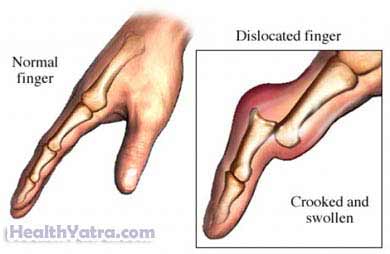Definition
A finger dislocation is when the a finger bone is knocked out of place. A dislocation also often involves stretching or damage to the ligaments. Ligaments are strong bands of fiber that help hold bones in place. Dislocation can happen in any of the finger joints.
Causes
A dislocated finger is usually caused by:
- A jamming force applied to the end of the finger
- Finger being forcefully twisted or bent
- Finger being overextended (bent backward)
Risk Factors
Factors that increase your risk of dislocation include:
- Contact sports
- Previous finger dislocation or sprain
- Medical conditions or disease that make ligaments weak or loose such as Ehlers-Danlos or Marfan syndrome
Symptoms
A dislocated finger may have:
- Severe pain
- Crooked or awkwardly bent shape
- Swelling and bruising in the injured area
- Numbness and/or tingling
- Inability to bend or straighten
Diagnosis
The doctor will ask about your symptoms and how the injury occurred. The injured finger will also be examined.
Your doctor may order an x-ray. This can help rule out broken bones. It may also be used to make sure the bone is back in the correct place.
Treatment
Emergency Care
Seek medical care right away. Do not try to put your finger bones back into place. If you wait for treatment, you could cause permanent damage.
The doctor will move the finger bones back into place. A local anesthesia may be used to help reduce pain. Your finger may then be placed in a splint or taped to the healthy finger. For severe injuries or ones that can not be moved back in to place by hand, a cast or surgery may be needed.
Home Care
You may still have swelling and discomfort after the doctor adjusts your finger. To help reduce swelling and pain try:
- Ice—Apply ice or a cold pack to your finger for 15-20 minutes, 3-4 times a day for several days. This helps reduce pain and swelling. Wrap the ice or cold pack in a towel. Do not apply the ice directly to your skin.
- Elevate—Try to hold the injured hand above the level of your heart. This is to help the swelling go down. For example, place your hand up on a pillow. Using a sling for a few days keeps the hand somewhat elevated.
- Over-the-counter medication—such as ibuprofen, naproxen, or acetaminophen
Once the pain is reduced, begin exercises to restore function and strength in your finger.
Prevention
To help prevent a finger dislocation wear proper padding and safety equipment when participating in sports. Work with a coach or other professional to learn proper techniques and safety steps.

